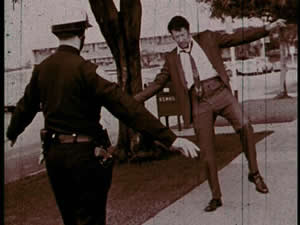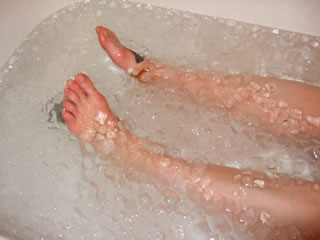Proprioception and Kinesthetic Awarness
/ To feel your body or not to feel your body, that is the question.
To feel your body or not to feel your body, that is the question.If only Hamlet had studied Tai Chi.
The tongue always feels things bigger than they actually are. If I try to feel the size of my hands with my eyes closed, they usually feel bigger than they actually are. I know how big they are supposed to be, but I still feel them bigger. If I keep my hands still for a few seconds with my eyes closed my sense of how big they are starts to morph into other shapes.
Taking drugs can disorient us so much that we do not feel our bodies. They can also cause us to feel our bodies in weird expansive or contracted shapes, or to feel intermittently. But we don't need drugs for this, if you are flirting to someone really hot, you might forget about your own body altogether. A great conversation, reading or writing, watching a movie, all of these everyday experiences can cause us to forget our bodies, to feel them in an exaggerated way, or to drift in and out.
 Traditionally strange feelings and disembodied feelings were covered under the subject: trance and possession. Now we have the scientific categories of proprioception and kinesthetic awareness.
Traditionally strange feelings and disembodied feelings were covered under the subject: trance and possession. Now we have the scientific categories of proprioception and kinesthetic awareness.Extreme relaxation, or extreme stillness often result in the sensation that ones body has no boundaries.
Pain starts with exaggerated feelings of the body and often leads in and out of feelings of disembodiment. There is nothing like getting hit to make you feel your body, but if you are going to keep fighting you need to "shake it off." What is being shaken off? A contracted sense of space?
When big muscles are engaged and experience resistance they cause us to feel our bodies at the expense of our sense of space and movement. Thus my often repeated comment that they make us insensitive. But more specifically what they are doing is making us feel in a limited way. Movement orients us, muscle tension reduces our ability of perceive.
There is a continuum of proprioception ability from superb to dysfunctional. The Sensory Processing Disorder website is a great place to learn about how to recognize proprioceptive problems in yourself and others.
Here is a really nice article that explains how proprioception interacts with other senses.
Here is an article about consciously training proprioception. It got me thinking about how my body learns, but practicing internal martial arts does everything these silly exercises do.
Of course there is always Wikipedia.
The traditional Chinese categories of shen, xin, jingshen, yi, jin, and shi all refer to and encompass aspects of proprioception and kinesthetic awareness. How else could "shi" be translated variously as: strategic advantage, a location at the center of change, potential energy, and the unification of active power with inner quiet.


 I read an essay years ago by Mark Elvin that readers of this blog might want to check out. It is called, "Tales of Shen and Xin: Body-Person and Heart-Mind in China During the Last 150 Years." It was published in the Zone Series from M.I.T. Press.
I read an essay years ago by Mark Elvin that readers of this blog might want to check out. It is called, "Tales of Shen and Xin: Body-Person and Heart-Mind in China During the Last 150 Years." It was published in the Zone Series from M.I.T. Press. The Art Work came from
The Art Work came from  Wow, it was fun putting those three names together.
Wow, it was fun putting those three names together. Wilhelm Reich
Wilhelm Reich Reich is also extraordinary because he was probably the first to say that Nazi's and Communists are the same. His reason was also way ahead of his time: They both used the same repressive physicality to perpetuate fear of self-awareness; a fear which makes people want to be told what to do.
Reich is also extraordinary because he was probably the first to say that Nazi's and Communists are the same. His reason was also way ahead of his time: They both used the same repressive physicality to perpetuate fear of self-awareness; a fear which makes people want to be told what to do. Katherine Dunham
Katherine Dunham  Here is an article from
Here is an article from  Yesterday, having just gotten into my warm car after watching the latest Stephen King movie and nearly freezing to death talking to a fellow movie goer in the wind, I saw a small group of high school girls crossing the street. Very sort pants, low socks, t-shirts. One of them had big lumps of plastic wrap around her knees and ankles. I suddenly registered that they were athletes and that the plastic wrap was holding large amounts of ice on the unfortunate young womans legs.
Yesterday, having just gotten into my warm car after watching the latest Stephen King movie and nearly freezing to death talking to a fellow movie goer in the wind, I saw a small group of high school girls crossing the street. Very sort pants, low socks, t-shirts. One of them had big lumps of plastic wrap around her knees and ankles. I suddenly registered that they were athletes and that the plastic wrap was holding large amounts of ice on the unfortunate young womans legs. Th
Th ere are a whole bunch of theories about why ice is good, but my experience tells me that mostly it is terrible. It is better than nothing on burns, but if you have burn cream, it is better. There is no question that ice can bring down swelling after an injury. For a really bad injury I would put ice on it right away. But as part of a training ritual, it is barbaric. It develops bad, tense, stiff, muscle quality and in the long run it probably leads to arthritis.
ere are a whole bunch of theories about why ice is good, but my experience tells me that mostly it is terrible. It is better than nothing on burns, but if you have burn cream, it is better. There is no question that ice can bring down swelling after an injury. For a really bad injury I would put ice on it right away. But as part of a training ritual, it is barbaric. It develops bad, tense, stiff, muscle quality and in the long run it probably leads to arthritis. When I was young and road my bicycle at high speed over steep hills to all my appointments, swam in the freezing cold ocean, did kungfu and dance for 6 or even 8 hours every day, and sat still (or slept) in stupid classes at school--a nice hot bath once or twice a week was very close to Nirvana. Still, as a training method it contributed nothing. I was tired and stiff because I was training too much of the wrong thing. It would be better just to train right. Too much hot drains the qi.
When I was young and road my bicycle at high speed over steep hills to all my appointments, swam in the freezing cold ocean, did kungfu and dance for 6 or even 8 hours every day, and sat still (or slept) in stupid classes at school--a nice hot bath once or twice a week was very close to Nirvana. Still, as a training method it contributed nothing. I was tired and stiff because I was training too much of the wrong thing. It would be better just to train right. Too much hot drains the qi. change some of your clothes.
change some of your clothes. I've been looking for information on Daoist ritual shoes. I was sure that somewhere I'd seen special Daoist ritual shoes which are 3 inch high stilts. These shoes make it impossible to put weight on the toes or the heel since the stilt post goes down from the center of the foot. Since the base the the stilt is thicker at the bottom, kind of like a mushroom, there is a plenty of space to balance. The problem is I have been unable to find these shoes (so no picture). Did I dream them? How embarrassing.
I've been looking for information on Daoist ritual shoes. I was sure that somewhere I'd seen special Daoist ritual shoes which are 3 inch high stilts. These shoes make it impossible to put weight on the toes or the heel since the stilt post goes down from the center of the foot. Since the base the the stilt is thicker at the bottom, kind of like a mushroom, there is a plenty of space to balance. The problem is I have been unable to find these shoes (so no picture). Did I dream them? How embarrassing. Dream or not, these shoes represent ultimate shamanic power. The symbolic steps Daoists take in ritual cover huge distances. They circumambulate the empire, the world, and they traverse the distances between stars in the sky.
Dream or not, these shoes represent ultimate shamanic power. The symbolic steps Daoists take in ritual cover huge distances. They circumambulate the empire, the world, and they traverse the distances between stars in the sky.
 kidney system. The kidneys regulate fluids in the body and they also produce jing. Jing is that aspect of qi which comprises the self reproductive quality in nature, it is stored in the kidney system where it is available both for making babies and for making repairs. Jing produces new tissue when we are injured, bone, muscle, scabs, etc. It is our ancestral memory.
kidney system. The kidneys regulate fluids in the body and they also produce jing. Jing is that aspect of qi which comprises the self reproductive quality in nature, it is stored in the kidney system where it is available both for making babies and for making repairs. Jing produces new tissue when we are injured, bone, muscle, scabs, etc. It is our ancestral memory. I don't think there is a perfect correlation between physical rigidity and a person's inability to freely make choices based entirely on what is real. There is some correlation, but I've met some amazing people with pretty screwed up bodies. Still, sit-ups are dumb. Six-pack abdominal muscles are O.K. against a boxer with gloves on and that's it. Like the "core-strength" fad, sit-ups break the unity of a person's body, they restrict the freedom of the torso and they tighten the breath. Why choose a rigid fate?
I don't think there is a perfect correlation between physical rigidity and a person's inability to freely make choices based entirely on what is real. There is some correlation, but I've met some amazing people with pretty screwed up bodies. Still, sit-ups are dumb. Six-pack abdominal muscles are O.K. against a boxer with gloves on and that's it. Like the "core-strength" fad, sit-ups break the unity of a person's body, they restrict the freedom of the torso and they tighten the breath. Why choose a rigid fate? A person standing on two feet is an unstable structure.
A person standing on two feet is an unstable structure.